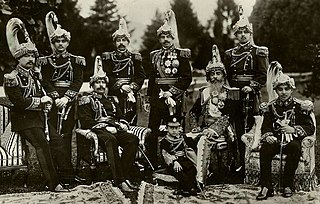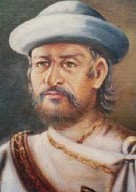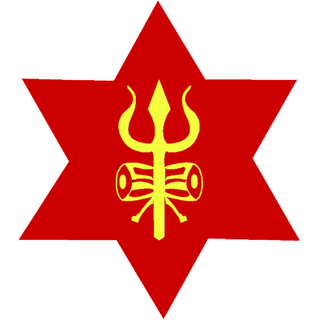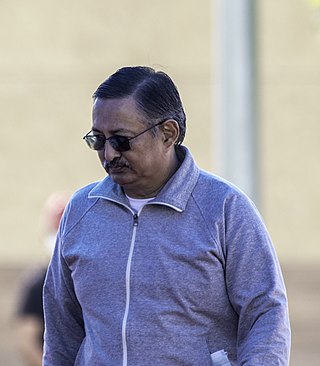Related Research Articles

Nepal is a multi-ethnic, multiracial, multicultural, multi-religious, and multilingual country. The most spoken language is Nepali followed by several other ethnic languages.

The politics of Nepal functions within the framework of a parliamentary republic with a multi-party system. Executive power is exercised by the Prime Minister and their cabinet, while legislative power is vested in the Parliament.

The Kingdom of Nepal was a Hindu kingdom in South Asia, formed in 1768 by the expansion of the Gorkha Kingdom, which lasted until 2008 when the kingdom became the Federal Democratic Republic of Nepal. It was also known as the Gorkha Empire, or sometimes Asal Hindustan. Founded by King Prithvi Narayan Shah, a Gorkha monarch who claimed to be of Thakuri origin from chaubisi, it existed for 240 years until the abolition of the Nepalese monarchy in 2008. During this period, Nepal was formally under the rule of the Shah dynasty, which exercised varying degrees of power during the kingdom's existence.

The Shah dynasty, also known as the Shahs of Gorkha or the Royal House of Gorkha, was the ruling Chaubise Thakuri dynasty and the founder of the Gorkha Kingdom from 1559 to 1768 and later the unified Kingdom of Nepal from 1768 to 28 May 2008.

The unification of Nepal was the process of building the modern Nepalese state, from fractured petty kingdoms including the Baise Rajya and the Chaubisi Rajya, which began in 1743 AD. The prominent figure in the unification campaign was Prithvi Narayan Shah, King of Gorkha. On 25 September 1768, he officially announced the creation of the Kingdom of Nepal and moved his capital from Gorkha to the city of Kathmandu.

The Rana dynasty was a Chhetri dynasty that imposed authoritarianism in the Kingdom of Nepal from 1846 until 1951, reducing the Shah monarch to a figurehead and making the Prime Minister and other government positions held by the Ranas hereditary. They are Kshatriya, whose ancestors were descended from the Ranas of Udaipur, Rajasthan, India. The Rana dynasty is historically known for their iron-fisted rule in Nepal. This changed after the Revolution of 1951 with the promulgation of a new constitution, when power shifted back to the monarchy of King Tribhuvan.

Nuwakot is a town in central Nepal, serving as the namesake of the district of the same name. The town is located on the bank of Trishuli and Tandi Rivers. It is located around 60 kilometres west of Kathmandu, and is known as a historic town which was the capital of the Valley in the days before the unification of Nepal by Prithvi Narayan Shah, and for more than 1,000 years the hilltop had served as a lookout and fort (kot) guarding the western entrance to Kathmandu Valley. Nuwakot served as an important trading hub for the Malla kings of the Valley, and was along a major transit route used for trade between India and Tibet. Making the Nuwakot hill as main forts including other eight forts: Malakot, Simalkot, Bhairabkot, Belkot, Kalikot, Salyankot, Dhuwankot and Pyaskot in its surrounding area, collectively named as 'Nawakotta'.

Basnyat/Basnet family or Basnyat/Basnet dynasty was a Khas-Chhetri and a warlord clan family involved in the politics and administration of the Gorkha Kingdom and Kingdom of Nepal. This family got entry into Thar Ghar aristocracy group of Gorkha at the time of King Prithvi Narayan Shah. It was one of the four noble families to be involved in active politics of Nepal together with the Shah dynasty, Pande family and the Thapa dynasty before the rise of the Rana dynasty. This family is descended from Shivaram Singh Basnyat, the commander of Gorkhali forces and a member of Shreepali Basnyat clan of Gorkha. This family was maritally linked to Kala (Black) Pande section of the Pande dynasty through Chitravati Pande who married Kaji Kehar Singh Basnyat. This family was the last Kshatriya (Chhetri) political family to be wiped out from the central power by Jung Bahadur Rana of Kunwar family during the Bhandarkhal Massacre in 1846 for the conspiracy to take the power leading to people suffering from 104 long years of the Rana rule.

Himachal Pradesh was established in 1948 as a Chief Commissioner's Province within the Union of India. The province comprised the hill districts around Shimla and southern hill areas of the former Punjab region. Himachal became a part C state on 1951 with the implementation of the Constitution of India. Himachal Pradesh became a Union Territory on 1 November 1956. On 18 December 1970 the State of Himachal Pradesh Act was passed by Parliament and the new state came into being on 25 January 1971. Thus Himachal emerged as the eighteenth state of the Indian Union.

Chaubisi Rajya, Chaubise Rajya or Chaubisye Rajya, were sovereign and intermittently allied petty kingdoms ruled by the Magar and Thakuri kings located at the intersection of Himalayas and the Indian subcontinent. One of these kingdoms, Gorkha, annexed the others, becoming the present-day country of Nepal. This conquest began soon after Prithvi Narayan Shah ascended to the Gorkha throne in 1743 AD. The Chaubisi Rajya were annexed during the unification of Nepal from 1744 to 1816 AD. A parallel group of 22 small kingdoms, Baisse Rajya, existed to the west of the Gandaki Basin.

The Nepali Army, also referred to as the Gorkhali Army, is the land service branch of the Nepali Armed Forces. After the Gorkha Kingdom was founded in 1559, its army was established in 1560, and initially became known as the Gorkhali Army. Later it was known as the Royal Nepali Army (RNA) following the Unification of Nepal, when the Gorkha Kingdom expanded its territory to include the whole country, by conquering and annexing the other states in the region, resulting in the establishment of a single united Hindu monarchy over all of Nepal. It was officially renamed simply to the Nepali Army on 28 May 2008, upon the abolition of the 240-year-old Nepalese monarchy, and of the 449-year-old rule of the Shah dynasty, shortly after the Nepalese Civil War.

Bal Krishna Khand is a former, Nepalese politician, former Home Minister of Nepal and a convict of the Bhutanese refugees scam recently unveiled. Khand is a central working committee member of the Nepali Congress party. Khand also served as the Defense Minister of Nepal under the Second Dahal cabinet.
The Thakuri is a Royal caste forming the core of the ruling class in Nepal. This term is a Nepali adaptation of the Indian title Thakur, which translates to 'master of the estate'. The term denotes the royal descendants of kings of Khasa Kingdom, Gandaki kingdom and the Kingdom of Nepal.
Kulamandan Khand (Nepali: कुलमण्डन खाण्ड) was the founder of Shah dynasty and the ancestor of King Prithivi Narayan Shah The title Shah was given by the king of delhi to khand thakuri of kaski for the act bravery. His son Yasho Brahma Shah succeeded him as the King of Lamjung and Kaski. His eldest son Narhari Shah became ruler of Lamjung while the second son ruled over Kaski. His youngest son, Dravya Shah ruled the Kingdom of Gorkha.
The Kunwar family was a noble Khas-Chhetri family in the Gorkha Kingdom and the Kingdom of Nepal. The Kunwars were linked to the Thapa dynasty and family of Amar Singh Thapa by marital lineages and, thus, to Pande dynasty through the Thapa dynasty. Three branches of the Kunwars; Ramakrishna, Jayakrishna and Amar Singh Kunwar were formed with opposite political aspirations. Bal Narsingh Kunwar supported Mukhtiyar Bhimsen Thapa while Chandrabir Kunwar supported Bada Kaji Amar Singh Thapa due to their marital relations with those families. Later, the Ramakrishna section of the family including Amarsingh established the Rana dynasty of Nepal and styled themselves as Rana Rajputs while Jayakrishna most section remained as Kunwars.
The Kingdom of Palpa was a petty kingdom in the confederation of 24 states known as Chaubisi Rajya. Palpa became part of the Kingdom of Nepal after Prime Minister Bhimsen Thapa ordered the beheading of Prithivipal Sen, King of Palpa.
Kaji Jayant Rana Magar was a Gorkhali general of the Gorkha Kingdom, and the Kingdom of Kantipur who commanded one battle for Gorkha, and two battles for Kantipur against the invasion of Nuwakot. He died in 1744 after ordering to be skinned alive by Prithvi Narayan Shah, first King of Nepal.
The Kingdom of Lalitpur, also known as Patan, was a kingdom ruled by the Malla dynasty of Nepal. It was established in 1482 after King Yaksha Malla's death. His sons divided the kingdom into four parts: Bhaktapur, Kantipur, Lalitpur, and Banepa.
Surapratap Shah or Surya Pratap Shah was a prince of the Gorkha Kingdom. He was active during the battles referred to as the Unification of Nepal led by his brother, King Prithvi Narayan Shah.
References
- ↑ Basnyat, Prem Singh (11 January 2021). "The great king who gave us Nepal". My Republica. Archived from the original on 28 January 2021. Retrieved 28 January 2021.
- ↑ Dangol, Sanu Bhai (1999). The Palace in Nepalese Politics: With Special Reference to the Politics of 1951 to 1990. Ratna Pustak Bhandar. p. 8.
- ↑ Khand, Jitendra Dhoj (2005). Strategic Thought. Aarati, Prapti, Ajeeta Khand. p. 197. ISBN 978-99946-57-64-3.